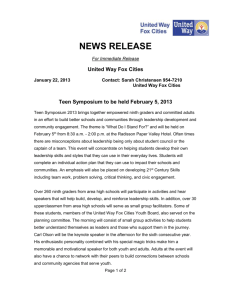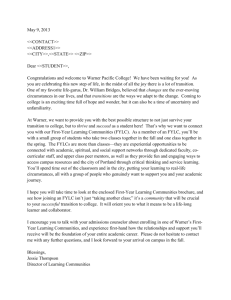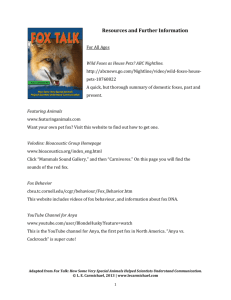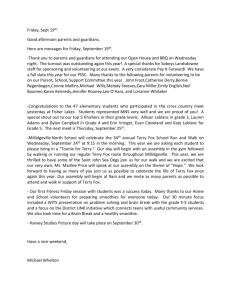Fox Cities LIFE Study shows community needs more living
advertisement
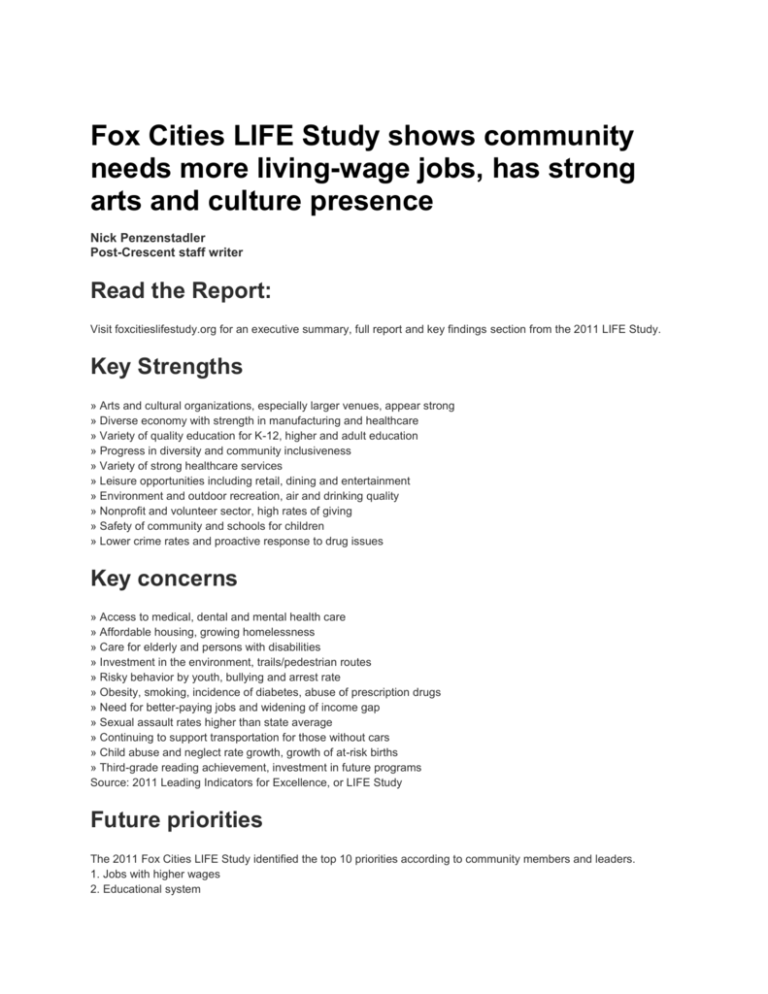
Fox Cities LIFE Study shows community needs more living-wage jobs, has strong arts and culture presence Nick Penzenstadler Post-Crescent staff writer Read the Report: Visit foxcitieslifestudy.org for an executive summary, full report and key findings section from the 2011 LIFE Study. Key Strengths » Arts and cultural organizations, especially larger venues, appear strong » Diverse economy with strength in manufacturing and healthcare » Variety of quality education for K-12, higher and adult education » Progress in diversity and community inclusiveness » Variety of strong healthcare services » Leisure opportunities including retail, dining and entertainment » Environment and outdoor recreation, air and drinking quality » Nonprofit and volunteer sector, high rates of giving » Safety of community and schools for children » Lower crime rates and proactive response to drug issues Key concerns » Access to medical, dental and mental health care » Affordable housing, growing homelessness » Care for elderly and persons with disabilities » Investment in the environment, trails/pedestrian routes » Risky behavior by youth, bullying and arrest rate » Obesity, smoking, incidence of diabetes, abuse of prescription drugs » Need for better-paying jobs and widening of income gap » Sexual assault rates higher than state average » Continuing to support transportation for those without cars » Child abuse and neglect rate growth, growth of at-risk births » Third-grade reading achievement, investment in future programs Source: 2011 Leading Indicators for Excellence, or LIFE Study Future priorities The 2011 Fox Cities LIFE Study identified the top 10 priorities according to community members and leaders. 1. Jobs with higher wages 2. Educational system 3. Health and youth 4. Healthy lifestyles 5. Meet basic needs 6. Infrastructure 7. Young professionals 8. Housing opportunities 9. Meet the needs of elderly 10. Protect public safety At its best, the Fox Valley is driven by an economy as diverse as its people, offering recreation and cultural opportunities at every turn. On the flipside, a new comprehensive study released today reveals growing communities grappling with a stagnant job market, increasing crime and a widening gap between rich and poor. The Fox Cities portion of the 2011 Leading Indicators for Excellence, or LIFE Study, provides deeper analysis of the regional quality of life snapshot released Tuesday. "Not surprisingly, the most predominant result was the feeling that we need to focus more on the creation of livingwage jobs in our region," said Curt Detjen, president and chief executive officer of the Community Foundation for the Fox Valley Region. Surveys indicated that 72 percent of community leaders and 66 percent of residents ranked "jobs with higher wages" as one of the Fox Cities' highest priorities, well above other priorities like the education system, health of youth or healthy living concerns. While the region has seen success with keeping and creating jobs, most come in the form of lower-paying jobs in service and tourism, according to Lora Warner, project manager for the study and director for Public Affairs at the University of Wisconsin-Green Bay. "Skilled jobs and manufacturing jobs are still a concern for many," Warner said. "Right now the income gap between the upper and lower groups is smaller than the U.S., but our gap is widening much faster." The national gap between the highest fifth and lowest fifth of salaries stands at a 15 to 1 ratio, from $11,817 to $177,225. In the Fox Valley, the highest fifth earned 10 times as much as the lowest, but grew nearly twice as fast as the U.S. gap between 2005 and 2007, according to the study. Economic forces also may have spurred incidences of crime and a surging rate of child abuse and neglect, according to Warner. Rates of abuse and neglect in Outagamie and Winnebago counties show a substantial increase since 2001, far exceeding Wisconsin's average. "That was one of the more troubling rates. I think the economy is a part of that with people working two jobs or working late," Warner said. The study surveyed 1,500 randomly selected Fox Cities residents, of which 375 responded. It also polled 305 community leaders and included work groups, interviews and panels. The overall study cost nearly $212,000. It was funded by 10 organizations, including United Way foundations. This year marks the third edition of the study in the Fox Cities. The study expanded to include southern Winnebago County and the Green Bay metro area for the regional version. Warner said the regional analysis allows communities to collaborate and compare priorities. She said the communities are much more similar than different, but vary in how they tackle socioeconomic problems. "Take dental care, for instance. Green Bay has made oral health a priority in its public schools whereas that's happening more for adults in Appleton and the Fox Cities," Warner said. "We also see an increase in the misuse of prescription drugs across the region, but are lucky to have the Town of Menasha that has started some education initiatives that could be a model." Headlining the broadly recognized strengths of the area were the arts and cultural opportunities. In 2010, two-thirds of community members rated cultural opportunities above average compared to 52 percent in 2000. "We are perceived very positively so far as arts and culture," said Margie Weiss, chair of the steering committee for the LIFE Study. "People feel there is an abundance of opportunity for the arts and it's something we can be proud of." The study particularly notes the growing usage of the library system and the development of the Trout Museum of Art, which leveraged a major donation of art to gain support for its remodel in downtown Appleton. The study did note that "by all accounts, opportunities may shrink due to reductions in budgets of all types and a struggling economy that is diverting financial resources to community needs seen more urgent." "That was one of the more troubling rates. I think the economy is a part of that with people working two jobs or working late," Warner said. The study surveyed 1,500 randomly selected Fox Cities residents, of which 375 responded. It also polled 305 community leaders and included work groups, interviews and panels. The overall study cost nearly $212,000. It was funded by 10 organizations, including United Way foundations. This year marks the third edition of the study in the Fox Cities. The study expanded to include southern Winnebago County and the Green Bay metro area for the regional version. Warner said the regional analysis allows communities to collaborate and compare priorities. She said the communities are much more similar than different, but vary in how they tackle socioeconomic problems. "Take dental care, for instance. Green Bay has made oral health a priority in its public schools whereas that's happening more for adults in Appleton and the Fox Cities," Warner said. "We also see an increase in the misuse of prescription drugs across the region, but are lucky to have the Town of Menasha that has started some education initiatives that could be a model." Headlining the broadly recognized strengths of the area were the arts and cultural opportunities. In 2010, two-thirds of community members rated cultural opportunities above average compared to 52 percent in 2000. "We are perceived very positively so far as arts and culture," said Margie Weiss, chair of the steering committee for the LIFE Study. "People feel there is an abundance of opportunity for the arts and it's something we can be proud of." The study particularly notes the growing usage of the library system and the development of the Trout Museum of Art, which leveraged a major donation of art to gain support for its remodel in downtown Appleton. The study did note that "by all accounts, opportunities may shrink due to reductions in budgets of all types and a struggling economy that is diverting financial resources to community needs seen more urgent.

